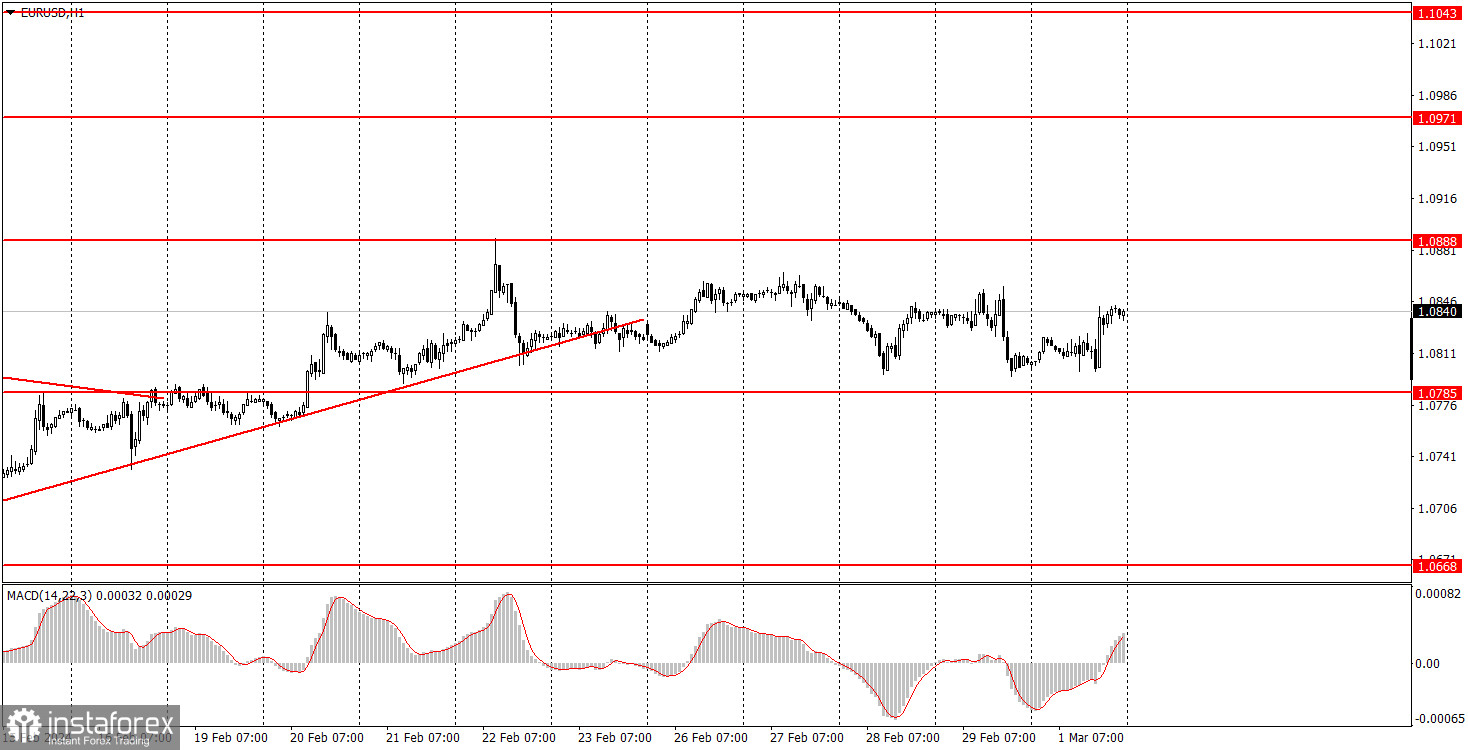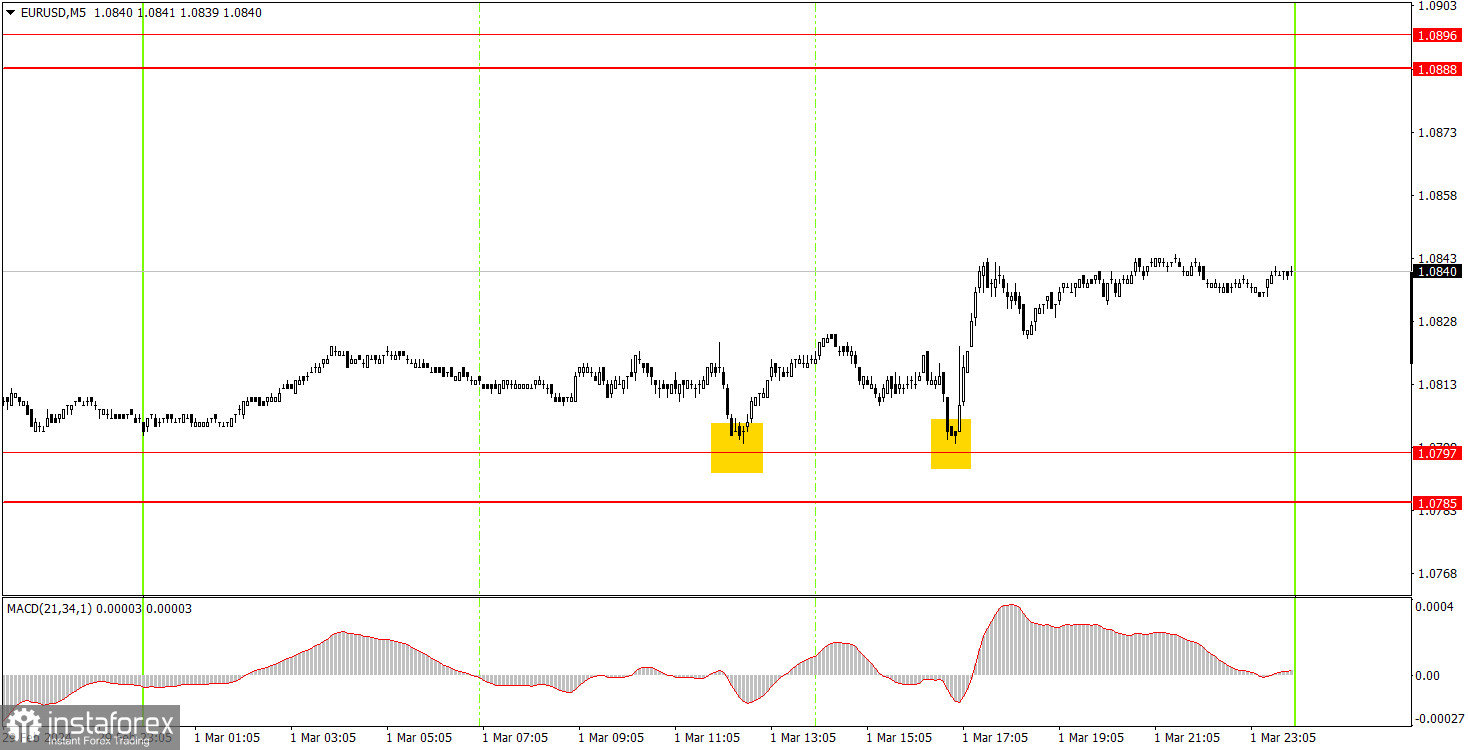Analyzing Friday's trades:
EUR/USD on 1H chart

EUR/USD continued to trade within a sideways channel. As seen in the chart above, even without additional figures, it is clear that the price has been moving sideways for almost two weeks. The working range is 1.0785-1.0888. Therefore, we have a classic flat with all the resulting consequences. Both major currency pairs are now trading in a limited price range. The uptrend seems to have ended, but we do not see any signs of a brewing downward trend. Therefore, until the price exits the specified range, one can only expect weak and confusing movements.
The volatility of the pair is a topic for a separate conversation. In recent months, it has fallen to the lowest levels. In most cases, the price does not even move 50 pips in a day, so it is very difficult to rely on strong signals and high profits. On Friday, the EU and the US both released important reports, but, as we can see, they practically did not affect the volatility and the flat movement.
EUR/USD on 5M chart

Two buy signals were formed near the level of 1.0797 on the 5-minute timeframe. In both cases, the price bounced off the specified level with a slight deviation. In both cases, beginners could open long positions. The first time, the price only climbed 15 pips, which was enough to set the Stop Loss to breakeven, and the trade was closed. The second time, the pair was up about 30 pips, and the trade should have been closed manually in the evening. Therefore, you could earn a bit.
Trading tips on Monday:
On the hourly chart, EUR/USD entered a total flat. We still expect the euro to resume its decline, which, in our opinion, should continue for quite some time. You may consider selling the euro after the price has settled below the level of 1.0785. Until then, the flat may persist.
The key levels on the 5M chart are 1.0568, 1.0611-1.0618, 1.0668, 1.0725, 1.0785-1.0797, 1.0888-1.0896, 1.0940, 1.0971-1.0981, 1.1011, 1.1043, 1.1091. On Monday, there are no interesting events scheduled in either the United States or the European Union. Volatility is likely to remain low or at zero, we shouldn't expect the flat phase to end. It will likely be another "boring Monday."
Basic trading rules:
1) Signal strength is determined by the time taken for its formation (either a bounce or level breach). A shorter formation time indicates a stronger signal.
2) If two or more trades around a certain level are initiated based on false signals, subsequent signals from that level should be disregarded.
3) In a flat market, any currency pair can produce multiple false signals or none at all. In any case, the flat trend is not the best condition for trading.
4) Trading activities are confined between the onset of the European session and mid-way through the U.S. session, after which all open trades should be manually closed.
5) On the 30-minute timeframe, trades based on MACD signals are only advisable amidst substantial volatility and an established trend, confirmed either by a trendline or trend channel.
6) If two levels lie closely together (ranging from 5 to 15 pips apart), they should be considered as a support or resistance zone.
How to read charts:
Support and Resistance price levels can serve as targets when buying or selling. You can place Take Profit levels near them.
Red lines represent channels or trend lines, depicting the current market trend and indicating the preferable trading direction.
The MACD(14,22,3) indicator, encompassing both the histogram and signal line, acts as an auxiliary tool and can also be used as a signal source.
Significant speeches and reports (always noted in the news calendar) can profoundly influence the price dynamics. Hence, trading during their release calls for heightened caution. It may be reasonable to exit the market to prevent abrupt price reversals against the prevailing trend.
Beginning traders should always remember that not every trade will yield profit. Establishing a clear strategy coupled with sound money management is the cornerstone of sustained trading success.





















